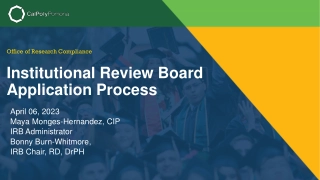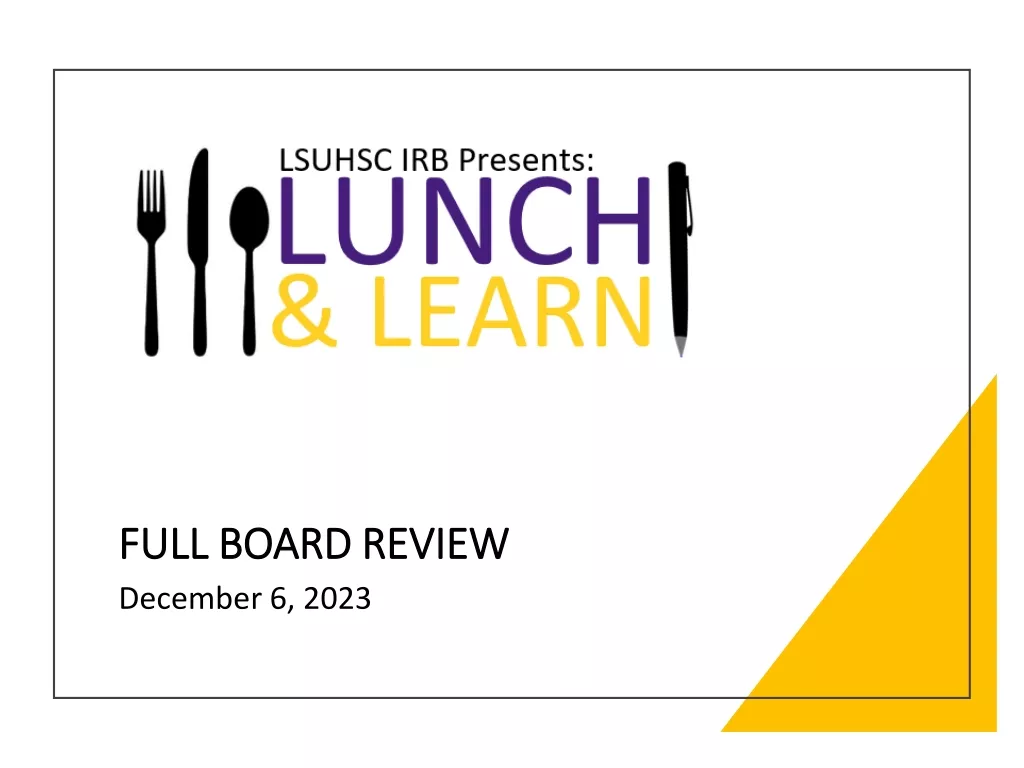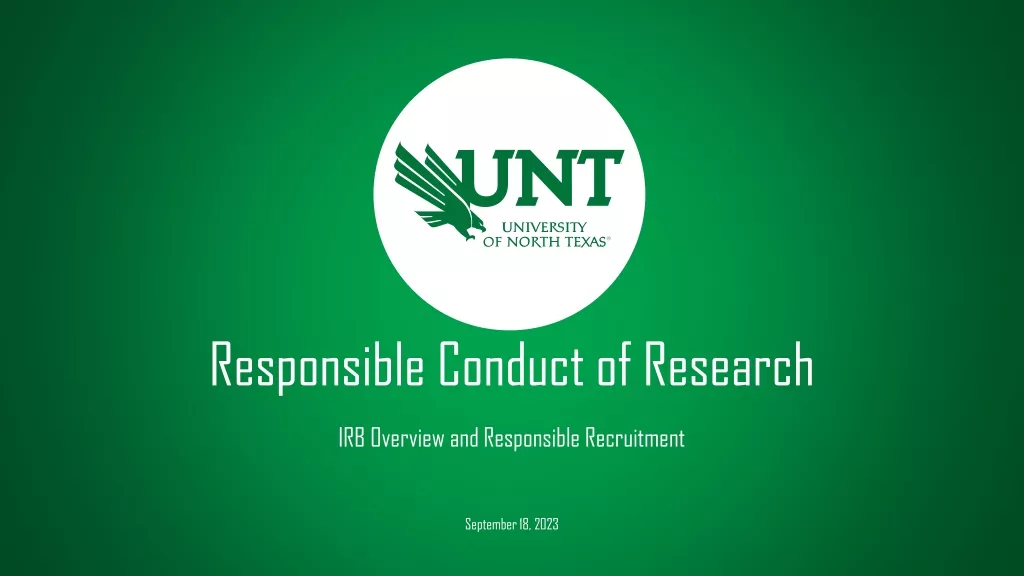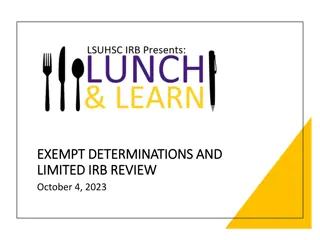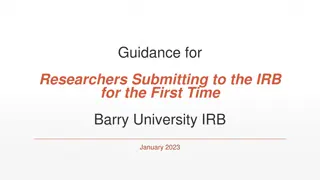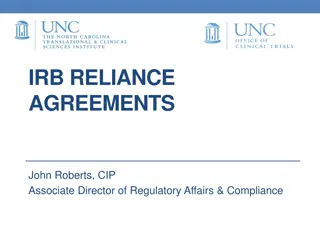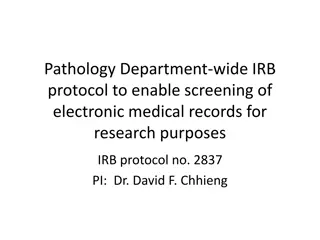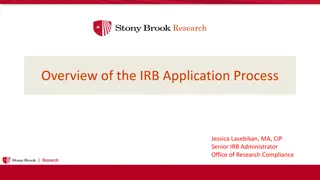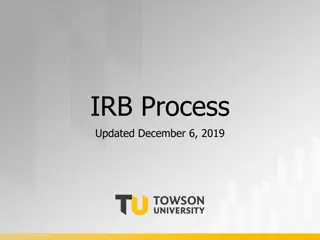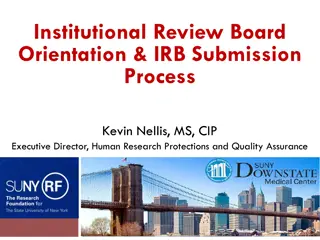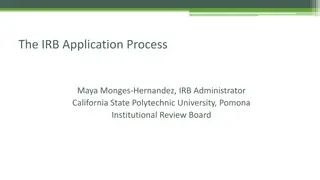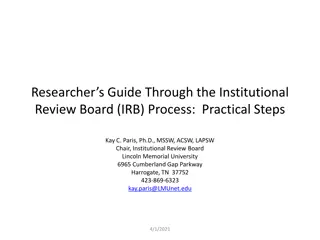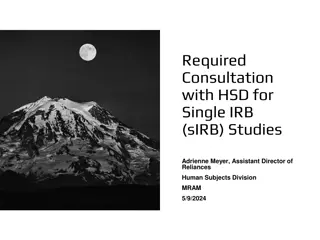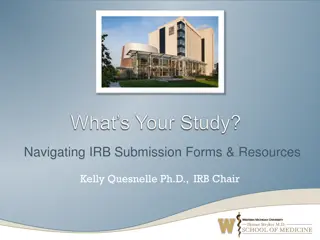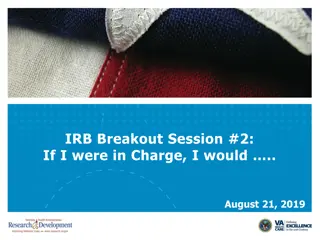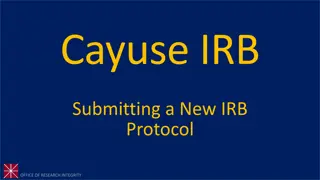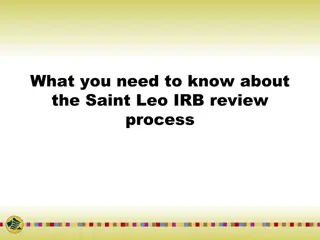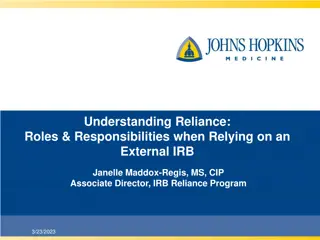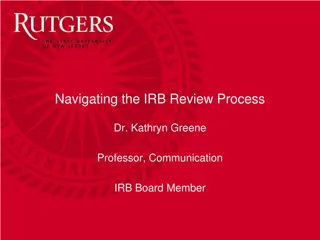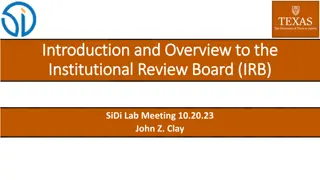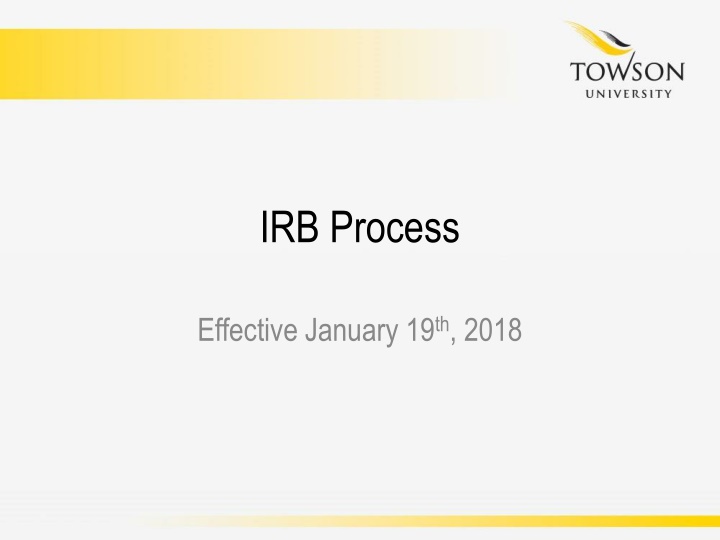
Institutional Review Board (IRB) Processes and Human Subjects Research
Explore the purpose of Institutional Review Boards (IRBs), the importance of Human Subjects Research, and the steps involved in the IRB review process. Learn about the principles guiding IRB activities, such as the Belmont Report and federal regulations, to ensure ethical treatment of human participants in research studies.
Download Presentation

Please find below an Image/Link to download the presentation.
The content on the website is provided AS IS for your information and personal use only. It may not be sold, licensed, or shared on other websites without obtaining consent from the author. If you encounter any issues during the download, it is possible that the publisher has removed the file from their server.
You are allowed to download the files provided on this website for personal or commercial use, subject to the condition that they are used lawfully. All files are the property of their respective owners.
The content on the website is provided AS IS for your information and personal use only. It may not be sold, licensed, or shared on other websites without obtaining consent from the author.
E N D
Presentation Transcript
IRB Process Effective January 19th, 2018
Institutional Review Board What is an IRB? What is its job? What are its guiding Principles? Belmont Report (i.e., Respect for Persons, Beneficence, Justice) Code of Federal Regulations, Title 45 Public Welfare, Part 46 Protection of Human Participants (aka The Common Rule) USM Policies and Procedures, Section III and Section IV
Determine Whether Your Study Requires IRB Review IRB PROCESS STEP 1
What is Human Subjects Research? HUMAN SUBECT RESEARCH Living individual about whom an investigator obtains, uses, studies, generates or analyzes: Private information Identifiable information A systematic investigation, including research development, testing, and evaluation, designed to develop or contribute to generalizable knowledge Through either Intervention Interaction
Ensure All Study Personnel Have Completed Human Subjects Protections Training IRB PROCESS STEP 2
Human Subjects Protections Training New User Click on Register to set up a free account Click on Affiliate with Another Institution; follow instructions Under Towson University Courses, Click on Add a Course Question 1: Responsible Conduct of Research optional Question 2: Skip Question 3: Faculty/Staff Select Social & Behavioral Research OR Biomedical Research Students Students Conducting No More than Minimal Risk Research Question 4: Not at this time, thank you Hit Submit CITI PROGRAM Complete all modules Should take several hours Score at least 80% Print out and submit copy of Completion Certificate NOTE: Studies will not be submitted for review UNTIL evidence of Human Subjects Protection Training has been provided by ALL study personnel involved in data collection or analysis
Determine Level of Review IRB PROCESS STEP 3
Minimal Risk As defined in 45CFR46.102.j, minimal risk . . . means that the probability and magnitude of harm or discomfort, anticipated in the research are not greater in and of themselves than those risks ordinarily encountered in daily life or during the performance of routine physical or psychological tests.
TYPES OF RESEARCH AND REVIEW CATEGORIES Types of Research Exempt Expedited Full Board Minimal risk research Data are anonymous OR No sensitive information collected Meets specific criteria Minimal risk research Sensitive information is collected Reasonable protections are in place to ensure confidentiality Meets specific criteria Greater than minimal risk Does not meet criteria for Exempt or Expedited research Accelerated Review Standard Review Full Board Review TU Review Categories Continuing Review? No Progress Report every 3 years Annually via Standard Review, Unless * Unless * (a) you intend to modify the study procedures or consent document; (b) a participant complains about the research or there is an adverse event; (c) there is a protocol violation/deviation; and/or (d) new findings indicate that the study risks, or the risk/benefit ratio, have change
Review Categories Accelerated Review Standard Review Full Board Review 3rd Friday of each Month 3rd Friday of each Month Deadline Rolling Form Request for Accelerated Review - Choose either Adult or Minor/Legal Minor version Request for Standard or Full Board Review Request for Standard or Full Board Review Reviewer Chair or Assistant Chair Single IRB Member Quorum of the IRB Time until Feedback or Approval ~ 1 week ~ 3 weeks ~ 4 weeks
Complete and Submit the Application IRB PROCESS STEP 4
The Successful IRB Application Provides detail about: Study rationale as well as aims or hypotheses Anticipated benefits Inclusion/Exclusion criteria Recruitment plan How informed consent will be obtained Provides detail about: Study procedures (i.e., in chronological order, what will subjects be asked to do) Measures to be used Anticipated risks and plans for mitigating or managing risks If applicable, a statement that there are no foreseeable risks
The Successful IRB Application Provides detail about: How confidentiality or anonymity will be assured How data will be stored to ensure security and who has access to data If/when/how data will be destroyed If/how subjects will be compensated Informed Consent/Assent** Includes all required elements (use TU Consent/Assent template) 8th grade reading level (adults) Appropriate reading level (children/adolescents) Sufficient detail so that participants understand risks and what is expected of them ** If data are anonymous, use an information sheet
The Successful IRB Application At minimum, attach the following: Informed consent form or information sheet Measures (or detailed description of questions, if proprietary), interview questions Human Subjects Protections Training certification If student PI, Faculty Advisor signature If appropriate also attach: Informed assent form Recruitment materials, including: Content of e-mails or letters Scripts for verbal recruitment Fliers Content of ads and where they will be placed Links to relevant websites
Revising Your Application Based on Reviewer Comments IRB PROCESS STEP 5
Revising your Application Address ALL reviewer concerns Submit a cover letter with the reviewer s comments and your response/revision If you disagree with a suggested revision In your response, provide a detailed explanation for why you disagree with the comment; be advised the reviewer may still require the revision if the rationale is not convincing Submit a revised protocol AND consent form Use track changes, highlighting, or different colored font for revisions DO NOT BEGIN DATA COLLECTION UNTIL APPROVAL FOR THE STUDY HAS BEEN GRANTED!! Once approved, you will receive notification from the IRB office you may begin data collection!
Amending Your Application After Approval IRB PROCESS STEP 6
Amending Applications All substantive changes to consent forms or protocols MUST be reviewed and approved by the IRB If not sure if change is substantive, ask Submit E-mail describing the change and its rationale Protocol with track changes, highlighting, or different colored font Consent form with track changes, highlighting, or different colored font Include: new questionnaires; recruitment materials, etc NOTE: You may not implement protocol changes until the IRB has approved the amendment
Some Final Thoughts What to do if . . . I want to include 17-year-old college students I want to pay participants I want to use data panels Someone complains about the research A participant experiences an adverse event There is a protocol deviation/violation NOTE: For more detailed information on all of these topics, see the Principal Investigator s Instruction Manual which is available on the IRB website


